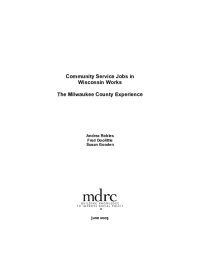Community Service Jobs in Wisconsin Works
The Milwaukee County Experience
Within Wisconsin Works (W-2), the state's TANF program, community service jobs (CSJs) are the most commonly assigned category, or "tier," of activities for welfare recipients, both statewide and within Milwaukee County. The CSJ tier is intended for individuals who are deemed not ready for immediate regular employment and is designed to provide an opportunity to practice work habits and skills. Most program participants entering the CSJ tier, which has a 24-month time limit, are assigned to work experience, but they also can be assigned to other activities such as further assessment, employment search, education, and training. They receive a cash benefit, case management, and other supportive services, though their cash benefits can be reduced if they do not meet the requirements set forth in their employment plan.
This report examines the implementation of the CSJ component of W-2 in Milwaukee County during the first three years of its operation. Milwaukee County serves the majority of the statewide W-2 caseload, and the program is being implemented by nongovernmental agencies, some nonprofit and some for profit, under contract with the state.
Key Findings
- The initial assignments of program activities for entrants into the CSJ tier gradually changed over the early years of the program. Work experience remained important throughout the period, with between 60 percent and 80 percent of participants assigned to this activity. However, other activities such as orientation and assessment, employment training, education, and soft-skills training increased substantially in importance. For example, the proportion of those assigned to education rose from 15 percent in the early months of the program to 50 percent in the program's second year.
- "Work experience" could mean very different things depending on the worksite to which a participant was assigned. Most participants were assigned to thrift store work, office and customer service work, child or adult care, and light industrial work or housekeeping. But about 25 percent were assigned to work experiences that included formal vocational training.
- The five local W-2 agencies differed in how they developed worksites and assigned participants to them. Two assigned many participants to operations that were part of the W-2 agency; others relied on a dispersed network of community organizations or on placements developed by a county agency. Within several agencies without a centralized CSJ department, the access of case managers to information about available worksites differed. A participant's access to the various types of worksites, however, was a function of the agency that served his or her geographic area and the caseworker assigned the case. These differences in access to placements were important because the work habits and skills developed in work experience depended on the worksite placement.
- Within the W-2 agency, both worksite supervisors and case managers play a central role in the administration of the CSJ program, and it is important that they be in close communication. Worksite supervisors reported that they would have liked more frequent contact with staff from the W-2 agency.
- Because of the time limits on CSJ participation, it is important to monitor attendance and respond to problems quickly to ensure that participants receive the services intended to improve their employability. It is also important to close W-2 cases when participation has ended, to prevent the time-limit "clock" from running when no W-2 service is provided. Monitoring attendance at worksites, however, was a substantial challenge due to confusion over administrative responsibilities within some W-2 agencies, assignment of participants to multiple activities (often not colocated), turnover and gaps in staffing, and the constant development of new CSJ worksites.






